A Comprehensive Guide to Working With Metallic Threads
Metallic threads are a wonderful, if frequently frustrating, addition to the world of quilting. Here we’ll talk about:
- Why we love metallic thread
- How to overcome the problems metallic threads cause
- And what types are available
The Science behind Glitter…and Metallic Threads
As all you fashionable ladies know, adding accessories to your fancy outfits can take an ensemble from nice to great in one fell swoop.
If your accessories glitter, that’s even better!
A little glitz really adds a LOT of bang for your buck. A gold necklace can take a black sweater from austere to rich, or a string of pearls can soften up a business suit.
Some of this is the human appreciation for beauty. Some of it might be the added perception of value – if it glitters, it must be worth more. I tend to think that a lot of it is the child within all of us, reaching out for something sparkly.
However it works, just know that most people enjoy sparkles, glitz, and glitter.
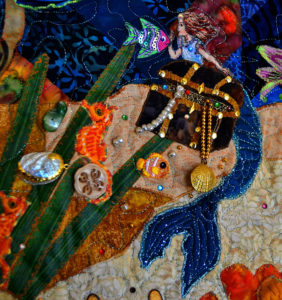
This picture of our mermaid in a tropical sea represents why we sew with metallic thread. The glitz and glitter can create an incredible feeling of 3-dimensional life when working with 2-dimensional mediums. The question is: “How do I achieve these results?”
Metallic threads are the quilting world’s glittery accessories, and they provide the exact same kind of instant love and attraction for quilters and non-quilters alike.
Metallics aren’t appropriate for every project, but it’s amazing how many places you can add them. And, just like your fashionable bling, they focus the eye, take your project up a bunch of notches, and make others “ooh” and “ahh” over the amazing talent of you.
The Problem with Metallic Threads
I don’t believe that “no good deed goes unpunished” but I do believe that for every wonderful thing in a quilter’s life – there is a downside.
- Sewing machines make sewing 100 times easier – until they break down
- Velvet adds texture and depth to a project – but you can’t iron on it
- Metallic threads are beautiful – but they are very challenging to sew with
Sewing with metallic threads can drive you zazbatt, because they have an annoying tendency to break, or strip out in the needle’s eye.
I first tried sewing with these sparkly threads about 5 years ago, and I quickly gave it up because they made me want to commit seppuku.
At the time I swore to heaven I would never, ever touch another thread that had a touch of glitz. However, like all addicts, I eventually got pulled back in because these threads are so very beautiful. This is where the closet masochism of quilters comes in.
Things in the quilting world had moved on since I’d given up metallic threads, and the new products convinced me to try again.
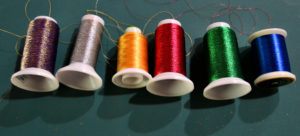
There’s huge variety available to quilters when it comes to choosing the right metallic thread. From cheap spools that can be found at Walmart, to designer quality only found in quilt stores, there is glitz and glitter available for your budget.
Time, trials, blood, sweat, and tears taught me a few things about using these diva-level beauties, and here is what I learned. There are two major tricks to handling metallic threads without going entirely insane:
Use the Right Needles
They now make special needles just for metallic threads. How awesome is that?
Metallic thread needles have been manufactured so that the problem of your thread being stripped as it goes through the eye is greatly reduced. (I’m not sure how this works, but I sure love the results.)
Some brands of metallic threads are more prone to stripping than others – particularly monofilament metallic – but these needles make the process much more enjoyable.
They’re also widely available, from quilt stores to Walmart. The most easily available metallic needles are made by SCHMETZ in size 80/12. You can get needles for metallic threads in various sizes, like any other needle, but I prefer the size 12 needles for my topstitching because they leave smaller holes than the larger ones.
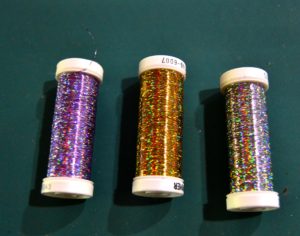
These Sulky Holoshimmer threads are the most beautiful metallic threads available today. However, they are the most difficult to work with. Do not attempt to use if you are a beginner, or if you don’t deal well with constant breakage in your thread.
Desperate Times Alternative
Once, when I needed these wonderful metallic needles very badly and the stores were out, a clerk suggested that I try the Jersey needles – also made by SCHMETZ – and surprisingly they work almost as well. Jersey thread needles are designed to handle slippery fabrics and delicate thread, so I keep a package as back-up.
Proper Bobbin Techniques
The breakage problem with metallic threads can be largely mitigated by working with your bobbin tension and the thread you use in your bobbin.
When I first started sewing seriously I always used the thread I was using in the topstitch line for my bobbin thread, and I almost always left my bobbin tension at its default setting. I eventually discovered that this is seldom a good idea, and never, ever when you’re sewing with glitzy threads.
*Note: These bobbin rules work for any type of lightweight or monofilament thread, especially invisible thread.
Finding the Right Bobbin Thread
One nightmare I lived through was using the same metallic thread in the bobbin that I was using on top. Not only was this a huge waste of this pricy thread – it snarled up within a few inches.
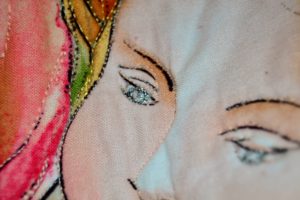
Sometimes all you need is a single spot of metallic thread. On this large panel we used silver metallic thread only in the eyes of the fairy. This is also a great way to start for beginners – but here’s a tip, loosen up your tension. If you make a mistake in an eye, and tear the fabric when pulling the stitches, you’ll wreck the entire panel. (Which might have almost happened with this Sweet Rose quilt – only we don’t admit to it!)
I also found that threads made especially made for bobbins like the Bottom Line threads, didn’t like sewing with the metallic threads.
Neither did Coats thread.
Finally, after a lot of experimentation, I found that for my machines, the best combination was to have a metallic thread on top, and AURIFIL quilting thread in the bobbin. Since all machines a little different, you will need to experiment with your own on fabric scraps to see what works for you.
The Right Bobbin Tension
Even with the threads right, your metallic thread will still break if you don’t adjust your bobbin tension.
Again, this will vary with each machine, but on mine, the default tension is 4. To successfully sew with metallic thread, though, I have to lower the bobbin tension to 2.
Play around on a scrap piece of fabric until the threads are pulling evenly through your machine.
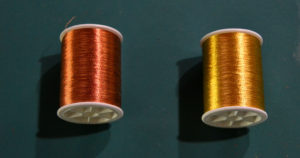
These beautiful colors work well on many different types of projects, and are almost as easy to sew with as normal threads.
*Side Note on Scrap Experiments: Your experiments will be useless unless you’re sewing on a scrap that is very similar in texture, fabric, and thickness to the project you’ll be working on. I try to keep a few scraps from my cutting for experimenting on each project. For example, if my project has cotton fabric on top and bottom, and 2 layers of batting, then I’ll make my scrap piece the same. This way you can get a much better idea of how the thread will perform in this instance.
What’s Available in the Wonderful World of Metallic Threads
Quilters have obviously clued into the beauty of metallic threads, since there are now many more brands available, and, as you would expect, they have different applications.
-
COATS
As of now, Coats carries gold, bronze and silver thread. Their thread is heavier so that it shows up more when you’re straight stitching. I use these when I want a very definitive look to my quilting – like when I’m highlighting.
-
SUPERIOR THREADS
This company now has a large inventory of metallics, and the last time I was in the quilt store, I noticed that they even had some variegated colors. I’m thinking hard where I can use them so that I can justify buying one or two. This is a medium weight thread and works well when you have areas where you require heavier quilting like satin stitching.
-
ULT PAPOS
This thread is made in Japan, and is a nice mid-weight thread. However, I’ve only found it in the size of Serger spools, and this doesn’t work well on my machine. You can overcome this irritation by spooling the thread onto an extra bobbin, and then using the bobbin as though it were a topstitch spool. ULT Papos does make very nice rich colors like royal blue, true red, and Christmas green.
-
YENMET
This thread also comes from Japan, and comes in smaller spools of 500m. Once again, it’s a mid-weight thread with lots of rich colors available.
-
SULKY HOLOSHIMMER
The secret to these threads are in the name – they shimmer because they’ve got lots of tiny iridescent variegations throughout. I use these when I’m doing fantasy panels like mermaids and fairies. These threads are my personal favorite because of the amazing colors – but they do have a downside, they break…a lot. And there’s really nothing to do about it since this is an extremely lightweight thread, and very thin. I often compare it to tiny strands of tinfoil. It’s also quite stretchy and so it also strips more easily than the other threads, but if you’re wanting to create an ethereal effect, this is the thread to use.
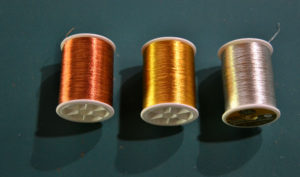
Coats Basic Metallic Threads
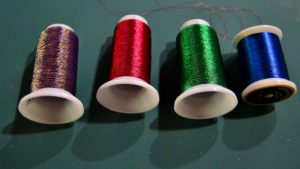
A Mix of Metallic Thread Brands
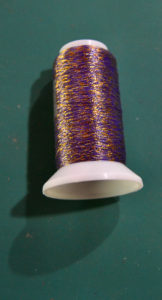
Either Yenmet or Ult Papos (the label’s long gone)
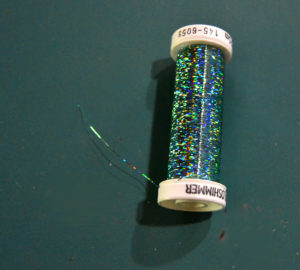
Sulky Holoshimmer (this is the thread used on the mermaid)
There may be other manufacturers out there, but these are the ones I’ve found and use all the time.
One Final Note
I always try to sew with my metallic threads in the early morning, when I’m fresh and my patience meter is full.
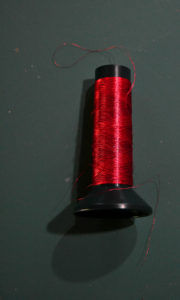
Even though metallics pose a real challenge, I would encourage you to try them, because as I said at the beginning, the bling they provide will take your project from merely great to effortlessly awesome.
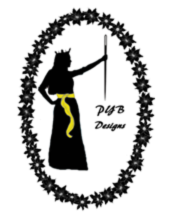
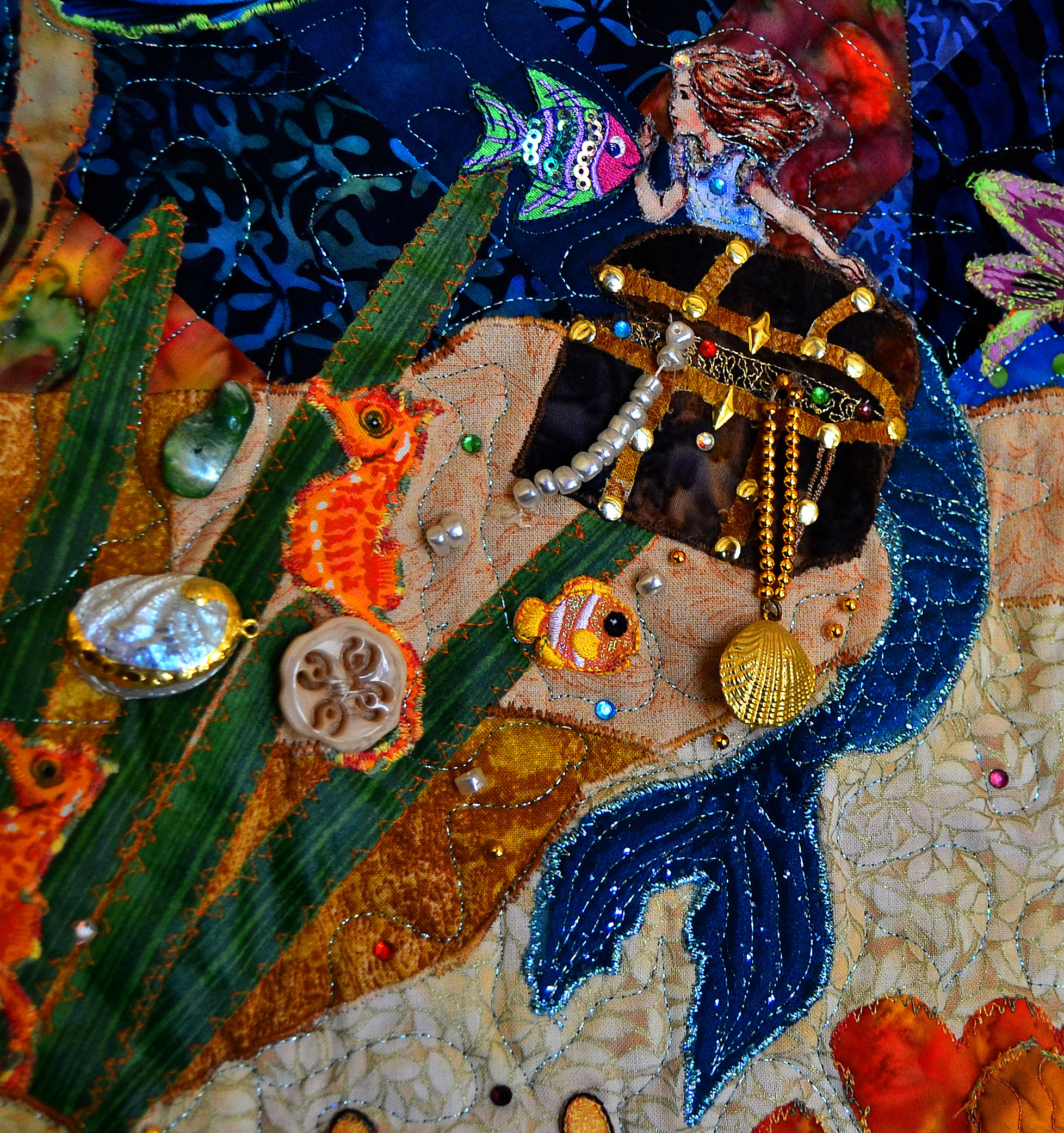
I’m truly enjoying the design and layout of your site. It’s a very easy on the eyes which makes it much more enjoyable for me to come here and visit more often. Did you hire out a developer to create your theme? Excellent work!
Thank you! No, this was a WordPress site designed from the Generate Press theme. All design is done in house (by me), as is the photography.
There’s definately a lot to find out about this subject. I really like
all the points you have made.
Hello there, just became aware of your blog through Google, and found
that it is truly informative. I am gonna watch out for brussels.
I’ll appreciate if you continue this in future. Numerous people will
be benefited from your writing. Cheers!
I think the admin of this web page is truly working
hard for his website, because here every stuff is quality based information.
Spot on with this write-up, I actually suppose this web site needs much more consideration. I’ll in all probability be once more to learn rather more, thanks for that info.